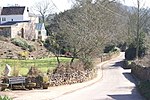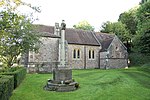Wookey Hole Caves () are a series of limestone caverns, a show cave and tourist attraction in the village of Wookey Hole on the southern edge of the Mendip Hills near Wells in Somerset, England. The River Axe flows through the cave. It is a Site of Special Scientific Interest (SSSI) for both biological and geological reasons. Wookey Hole cave is a "solutional cave", one that is formed by a process of weathering in which the natural acid in groundwater dissolves the rocks. Some water originates as rain that flows into streams on impervious rocks on the plateau before sinking at the limestone boundary into cave systems such as Swildon's Hole, Eastwater Cavern and St Cuthbert's Swallet; the rest is rain that percolates directly through the limestone. The temperature in the caves is a constant 11 °C (52 °F).
The caves have been used by humans for around 45,000 years, demonstrated by the discovery of tools from the Palaeolithic period, along with fossilised animal remains. Evidence of Stone and Iron Age occupation continued into Roman Britain. A corn-grinding mill operated on the resurgent waters of the River Axe as early as the Domesday survey of 1086. The waters of the river are used in a handmade paper mill, the oldest extant in Britain, which began operations circa 1610. The low, constant temperature of the caves means that they can be used for maturing Cheddar cheese.
The caves were the site of the first cave dives in Britain, undertaken by Jack Sheppard and Graham Balcombe in the 1930s. Since then, divers have explored the extensive network of chambers developing breathing apparatus and novel techniques in the process. The full extent of the cave system is still unknown with approximately 4,000 metres (13,000 ft), including 25 chambers, having been explored. Part of the cave system opened as a show cave in 1927 following exploratory work by Herbert E. Balch. As a tourist attraction it has been owned by Madame Tussauds and, most recently, the circus owner Gerry Cottle. The cave is notable for the Witch of Wookey Hole, a roughly human-shaped stalagmite that legend says is a witch turned to stone by a monk from Glastonbury. It has also been used as a location for film and television productions, including the Doctor Who serial Revenge of the Cybermen.









